This fall, while strolling through my neighbourhood, I caught out of the corner of my eye two cactus plants sitting next to the garbage bins of a large high rise. Not being one to shy away from free, discarded stuff, I casually veered off path to check it out. What I discovered were two, fairly large, but very neglected cacti from the genus Epiphyllum.
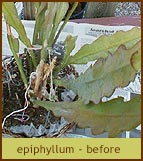
They were both contained within too-small, decaying wicker baskets with very little and very compacted ‘soil’. I use the word soil very loosely here. Both plants had several stems (technically flattened stems, in the case of Epicacti) that were completely brown, dry and dead and others that were on the way with spots and patches of dead foliage. After a quick inspection of the foliage and roots of both plants, only one showed potential for revival: new, unblemished growth in the form of a single, shiny stem. I picked this one up and decided to take it home and see what I could do for it. Under usual circumstances I wouldn’t recommend bringing home cast away plants. Who knows what diseases they may harbour, diseases could be passed onto your current population at home. Yet I find it difficult to turn away anything in distress, and this plant had potential to be revived to a healthy specimen. Even if you don’t plan on adopting plants that have been thrown to the curb, the following will be helpful for those of you with dead or dying cacti that you’re sure are beyond hope.
The first thing I did was bring the ‘dead’ plant inside to get warm. It was a cool, autumn evening and the plant could have been out in the cold for any length of time. Cold weather can cause a lot of damage to a cactus, including a browning or blackening of the foliage that leads to the eventual death of parts of the plant. The first rule in keeping any cactus or succulent that is not cold hardy, unlike the popular northern climate Hens and Chicks (Sempervivum), is: keep them in a place that is free from cold draughts. I set the plant in a spot away from direct light and quarantined away from my other plants for a few days. Not just because I was lazy, but because I felt that the plant had been through enough without me poking and prodding and cutting and repotting it. Repotting a plant can be a stressful situation, even though the ultimate effect is to improve the plant’s growing conditions, so I didn’t want to subject it to too much all at once.
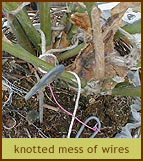 After letting it rest a few days, I prepared the plant for repotting. First I removed it from the horrible bondage of the basket. Someone had the bright idea of using wire, string and all sorts of miscelleny in an attempt to hold the plant upright. All they really needed to do was replant it. The plant had simply become too big for the basket; I suspect the leaves were pulling the lightweight basket over. A bigger, heavier terra cotta pot would have solved the problem.
After letting it rest a few days, I prepared the plant for repotting. First I removed it from the horrible bondage of the basket. Someone had the bright idea of using wire, string and all sorts of miscelleny in an attempt to hold the plant upright. All they really needed to do was replant it. The plant had simply become too big for the basket; I suspect the leaves were pulling the lightweight basket over. A bigger, heavier terra cotta pot would have solved the problem.
Next I gently teased the hard, compacted ‘soil’ away from the roots. The roots and the dirt had essentially fused into one. Water can be used to soften hardened soil away from roots, but in this extreme case no amount of soaking would have helped. As I pulled back the soil I was shocked to discover that the roots were hiding terra cotta balls that are often used in pots for holding moisture. They are usually used on the soil surface, not underneath. In this case the balls were of no use. Terra cotta balls will only hold as much water as you make available to them. I doubt anyone had made water available to this plant in some time. My second, predictable, discovery was that the roots were pretty much dead. I cut back nearly all of them with a sharp pair of pruners. Cutting back dead roots is a good idea since they aren’t doing anything for the plant and will rot once exposed to water. It’s important to get most of the decaying, rotted plant matter away from the plant and expose the healthy parts to encourage new growth.
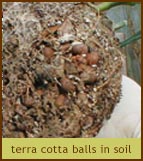 Note: If you do cut into the healthy roots or new growth of a cactus or succulent, it’s important to give the plant a week or two to heal over and form scabs before you repot it in fresh soil. Leave the plant exposed and outside of soil, resting on a piece of paper away from direct light or draughts. Dip the exposed roots into some powdered rooting hormone or green sulphur to encourage healing, fresh root growth, and to prevent fungal rot.
Note: If you do cut into the healthy roots or new growth of a cactus or succulent, it’s important to give the plant a week or two to heal over and form scabs before you repot it in fresh soil. Leave the plant exposed and outside of soil, resting on a piece of paper away from direct light or draughts. Dip the exposed roots into some powdered rooting hormone or green sulphur to encourage healing, fresh root growth, and to prevent fungal rot.
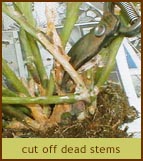 After I removed the dead roots I removed dead foliage. This step can be done at the same time as cutting the roots. The ‘healing period’ applies only to cuts made to ends at the bottom of the plant – areas that will be pressed into the soil to later form roots. Stems and other foliage can be cut off a plant at any time. With a pair of sharp pruning shears, I began to remove the unhealthy, brown and dead stems at the base of the plant. This plant had so much dead foliage, that when all was said and done there was only one good stem left: the one healthy and shiny new stem that made me bring the plant home in the first place. I did leave three additional stems intact, because I didn’t feel the plant had much of a chance with only one stem left to support the whole plant. The survivors were very pale and dull, but didn’t have scarred brown patches like the stems I cut off. I thought that perhaps with exposure to proper light they had a chance to regain some vibrancy and colour.
After I removed the dead roots I removed dead foliage. This step can be done at the same time as cutting the roots. The ‘healing period’ applies only to cuts made to ends at the bottom of the plant – areas that will be pressed into the soil to later form roots. Stems and other foliage can be cut off a plant at any time. With a pair of sharp pruning shears, I began to remove the unhealthy, brown and dead stems at the base of the plant. This plant had so much dead foliage, that when all was said and done there was only one good stem left: the one healthy and shiny new stem that made me bring the plant home in the first place. I did leave three additional stems intact, because I didn’t feel the plant had much of a chance with only one stem left to support the whole plant. The survivors were very pale and dull, but didn’t have scarred brown patches like the stems I cut off. I thought that perhaps with exposure to proper light they had a chance to regain some vibrancy and colour.
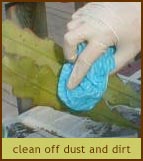 Another problem that could account for the dull, lifeless appearance of the stems was the amount of dirt and dust covering the plant. A layer of filth on a plant can prohibit it from obtaining enough light and carbon dioxide needed to carry out photosynthesis. The process of photosynthesis is a plant’s main mode of food production. Inhibit photosynthesis and a plant will deteriorate. A quick fix to this problem is simply to wash the leaves. I used a few drops of liquid dish soap diluted in a bowl of room temperature water. Using a clean cloth, I carefully wiped the flattened stems of the plants clean and then used fresh water to rinse them off.
Another problem that could account for the dull, lifeless appearance of the stems was the amount of dirt and dust covering the plant. A layer of filth on a plant can prohibit it from obtaining enough light and carbon dioxide needed to carry out photosynthesis. The process of photosynthesis is a plant’s main mode of food production. Inhibit photosynthesis and a plant will deteriorate. A quick fix to this problem is simply to wash the leaves. I used a few drops of liquid dish soap diluted in a bowl of room temperature water. Using a clean cloth, I carefully wiped the flattened stems of the plants clean and then used fresh water to rinse them off.
After performing foliar surgery and cleanup it was time to create a new home for the plant. I selected a pot that was big enough to accommodate its’ oddly shifted weight. Cacti should be potted in containers that are in proportion to their size. Usually ½ to 1 inch of space between the plant and the pot edge is sufficient for small plants, while larger plants require a good inch or so. Terra cotta is best, not only because the weight provides stability for the plant, but because it allows the soil to breath, preventing root rot which so frequently occurs as the result of over-watering and lack of air circulation. 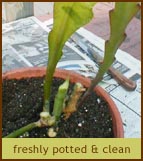 In the past I have had a tough time finding ready-made commercial cactus and succulent soil mixes that were suitable for potting. They are either too rocky or too sandy. I usually mix 2 1/2 parts of a mostly sand soil with 1 1/2 part good all-purpose potting soil. The general rule for mixing your own cactus soil is 1 part organic matter such as peat, loam, compost or some kind of soil-less potting mix, 2 parts coarse sand and 1 part inorganic matter such as grit, perlite (the white, foamy bits), or crushed lava rock. Additional nutritional supplements such as limestone or potassium can also be added. Keep in mind that although an epipyllum is a member of the cactus family, it is a jungle cactus that likes high humidity and moist, but not wet or soggy soil. As a result I have added extra humus to this soil mix.
In the past I have had a tough time finding ready-made commercial cactus and succulent soil mixes that were suitable for potting. They are either too rocky or too sandy. I usually mix 2 1/2 parts of a mostly sand soil with 1 1/2 part good all-purpose potting soil. The general rule for mixing your own cactus soil is 1 part organic matter such as peat, loam, compost or some kind of soil-less potting mix, 2 parts coarse sand and 1 part inorganic matter such as grit, perlite (the white, foamy bits), or crushed lava rock. Additional nutritional supplements such as limestone or potassium can also be added. Keep in mind that although an epipyllum is a member of the cactus family, it is a jungle cactus that likes high humidity and moist, but not wet or soggy soil. As a result I have added extra humus to this soil mix.
After potting the plant in its fresh and dry new soil bed, do not water it for 2 or more weeks. After the prescribed time, water sparingly for several more weeks. Watering the plant right away may cause fungal rot to take place at the base of the plant, before it has time to become established and grow roots.
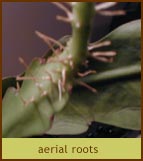 Epilogue: It has been well over a month now since I first found the plant and repotted it. It had a bad start: two of the remaining stems were accidentally burned by a candle flame. Luckily they weren’t good stems and the plant recovered well from the trauma. I keep it near a sunny window and a grow light since the short winter days are often dark and sunless. The one good stem has grown considerably and even has aerial roots growing from the end. The other stems have taken on a darker green colour as opposed to the dull, yellowy-beige colour they first had. They too have begun to grow from the tips. There are three new stems emerging from stem stumps at the base and there has been considerable healthy root growth. The plant is still fairly ugly now but over time it will shed its battle scars and become a beautiful, healthy epiphyllum that I can proudly say I saved.
Epilogue: It has been well over a month now since I first found the plant and repotted it. It had a bad start: two of the remaining stems were accidentally burned by a candle flame. Luckily they weren’t good stems and the plant recovered well from the trauma. I keep it near a sunny window and a grow light since the short winter days are often dark and sunless. The one good stem has grown considerably and even has aerial roots growing from the end. The other stems have taken on a darker green colour as opposed to the dull, yellowy-beige colour they first had. They too have begun to grow from the tips. There are three new stems emerging from stem stumps at the base and there has been considerable healthy root growth. The plant is still fairly ugly now but over time it will shed its battle scars and become a beautiful, healthy epiphyllum that I can proudly say I saved.